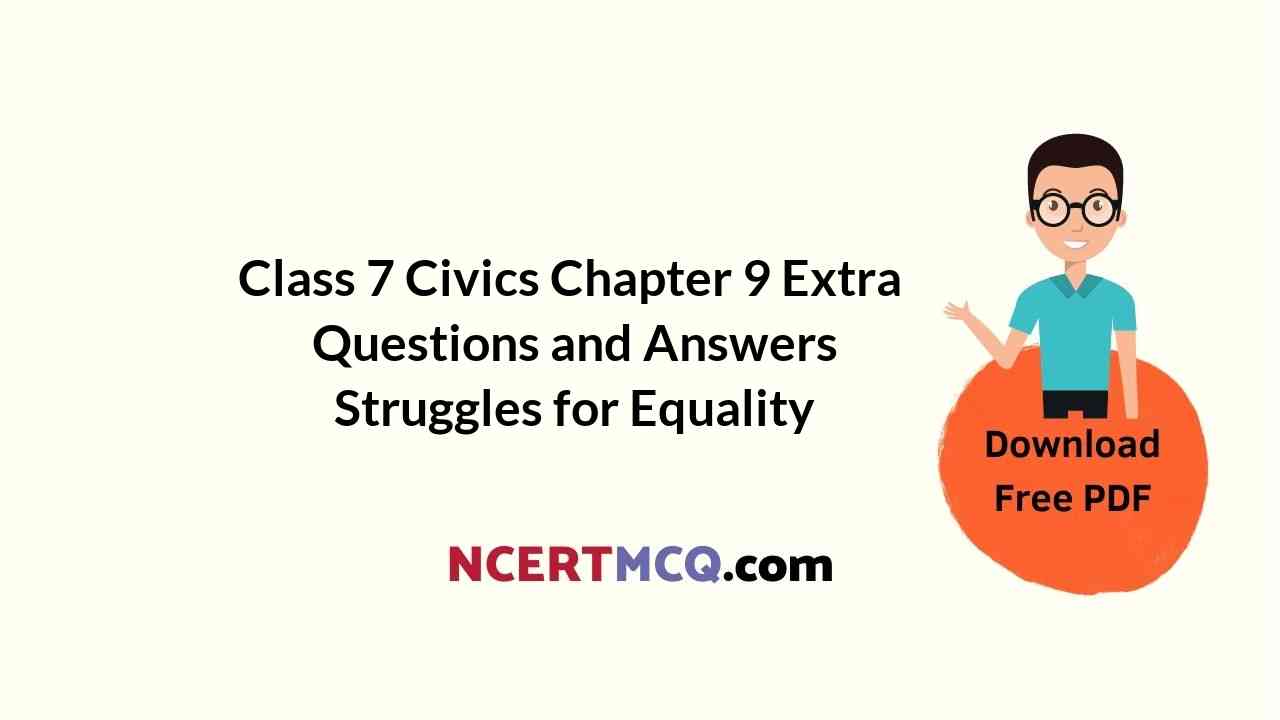Here we are providing Class 7 Civics Chapter 9 Extra Questions and Answers Struggles for Equality was designed by subject expert teachers. https://ncertmcq.com/extra-questions-for-class-7-social-science/
Struggles for Equality Class 7 Extra Questions Civics Chapter 9
Struggle For Equality Class 7 Extra Questions And Answers Question 1.
Who is Swapna and what does she do?
Answer:
Swapna is a small farmer in Kurnool and she grows cotton.
Class 7 Civics Chapter 9 Extra Questions Question 2.
What is putting out system?
Answer:
The arrangement between the merchant and the weavers is known as putting-out system.
Struggles For Equality Class 7 Extra Questions Question 3.
To whom does the Erode merchant supply the cotton cloth?
Answer:
The Erode merchant supplies the cotton cloth to a garment exporting factory near Delhi.
Struggles For Equality Class 7 Questions And Answers Question 4.
Write about Erode’s cloth market in brief.
Answer:
Erode is a bi-weekly cloth market in Tamil Nadu. It is one of the largest, cloth markets in the world. A large variety of clothes are sold in this market.
![]()
Class 7 Civics Ch 9 Extra Questions Question 5.
What is the role of merchants in making the clothes?
Answer:
The merchant distributes work among the weavers based on the orders he has received for cloth. For this, he buys the yarn and gives to the weavers with instructions about the kind of cloth that is to be made.
Ch 9 Civics Class 7 Extra Questions Question 6.
What is the role of market in the lives of people related to cloth?
Answer:
The market offers people, related to cloth, opportunities for work and to be able to sell things that they grow or produce. It could be the farmer selling cotton or weaver producing cloth.
Struggle For Equality Class 7 Questions And Answers Question 7.
Why have the poor people to depend on rich persons?
Answer:
The poor have people to depend on the rich and the powerful persons for loans, raw materials and marketing of their goods, and most often for employment.
![]()
Class 7 Civics Chapter 10 Extra Questions Question 8.
How do the cotton cloths reach from weavers to buyers in the USA and Europe?
Answer:
- The weavers produce cotton cloths either themselves or on order from the merchants.
- For this, the weavers get the yarn from the merchant and supply them the cloth.
- The merchant supplies the cotton cloth to garment exporting factory.
- The garment exporting factory uses the cloth to make shirts. The shirts so made are exported to the foreign buyers in the USA and Europe.
Multiple Choice Questions (MCQs)
1. The story of a shirt begins with;
(a) the production of cotton
(b) sale of the cotton
(c) picking cotton balls
(d) growing the cotton.
Answer:
(a) the production of cotton.
2. In which one of the following states is Kurnool situated?
(a) Rajasthan
(b) Uttar Pradesh
(c) Andhra Pradesh
(d) Punjab.
Answer:
(c) Andhra Pradesh.
3. Which one of the following is the bi-weekly cloth market in Tamil Nadu?
(a) Kurnool market
(b) Erode’s bi-weekly market
(c) Chennai market’
(d) Kalpakkam market.
Answer:
(b) Erode’s bi-weekly market.
4. Who give the yarn to the weavers in Tamil Nadu?
(а) Big farmers
(b) They grow cotton in their fields
(c) Exporter
(d) Merchants.
Answer:
(d) Merchants.
![]()
5. The arrangement between the merchant and the weavers is an example of;
(a) barter system
(b) putting-out system
(c) putting-in system
(d) weaving system.
Answer:
(b) putting-out system.
6. What is the putting-out system?
(a) The merchant supplies the raw materials.
(b) Merchant receives the finished products.
(c) The merchant supplies the raw materials and receives the finished products.
(d) The merchant provides handlooms to the weavers.
Answer:
(c) The merchant supplies the raw materials and receives the finished products.
7. A chain of markets links the;
(a) producer of cotton to the buyer at local market.
(b) buyer at local market and supermarket.
(c) various buyers at the supermarket.
(d) producer of cotton to the buyer at super market.
Answer:
(d) producer of cotton to the buyer at supermarket.
8. Which one of the following steps is taken place at every place in the market chain?
(а) Buying and selling
(b) Import and export
(c) Production and selling
(d) Growing and production.
Answer:
(а) Buying and selling.
9. Which one of the following has made huge profits in the market?
(а) Local traders
(b) Farmers
(c) Foreign business person
(d) Exporters.
Answer:
(c) Foreign business person.
10. Which one of the following is different from the other three, with reference to dependence of poor people on the rich?
(a) For loan
(b) For raw materials
(c) For employment
(d) For clothes.
Answer:
(d) For clothes.
![]()
Important Terms:
Ginning mill: It is a factory where seeds are removed from cotton bolls. The cotton is pressed into bales to be sent for spinning into thread.
Exporter: A person who sells goods abroad is known as exporter.
Profit: The amount that is left or gained from earnings after deducting all the costs. If the costs are more than the earnings, it would lead to a loss.
